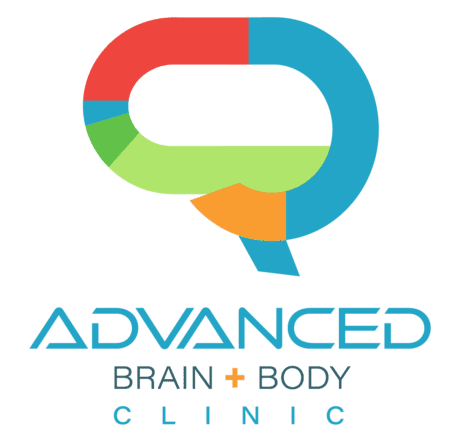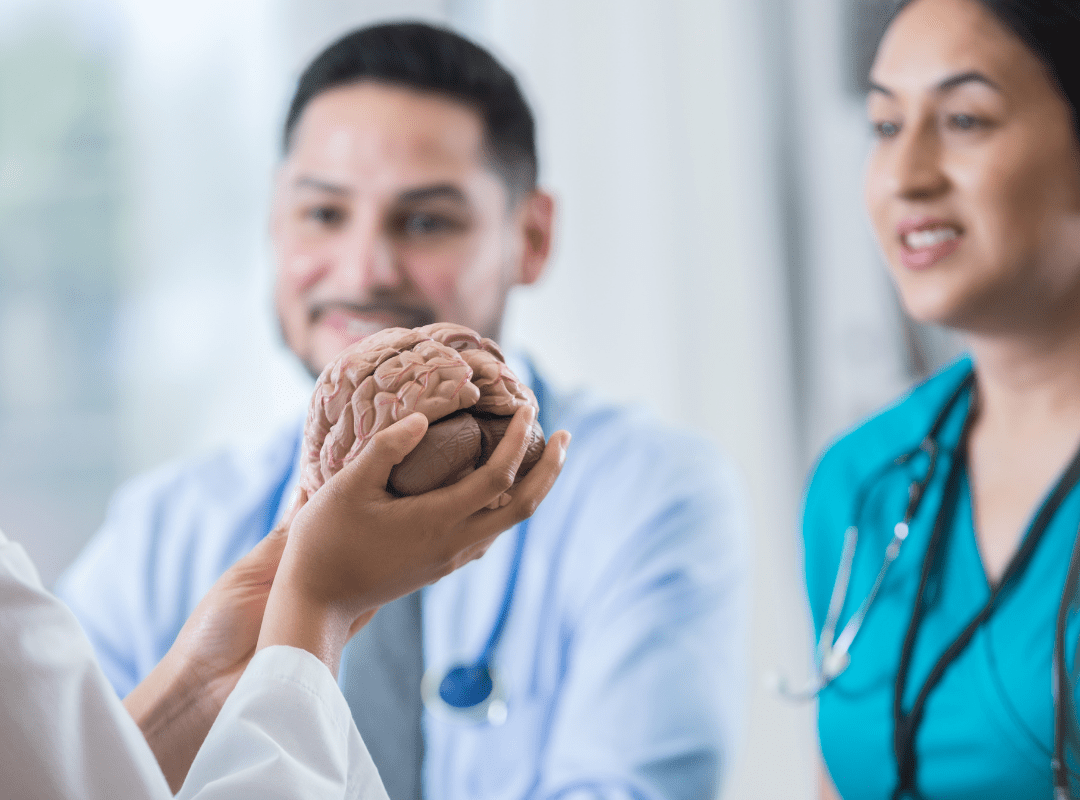At the recent Minnesota Medical Association annual conference, many important questions were asked by primary care and specialist physicians during the session titled: The Use of Ketamine, Esketamine (often referred to by its brand name Spravato in Minnesota), and TMS in Depression. In today’s article, we highlight answers presented by AB+BC’s psychiatrists Dr. Steve Manlove, MD and Dr. Brian Johns, MD, co-founders of Advanced Brain + Body Clinic Ketamine TMS.
Knowing that other doctors have the same questions and need answers, we wanted to capture the key Q&A elements here. We receive referrals daily from primary doctors and specialists alike looking for help with severe depression, anxiety, and PTSD patients who just aren’t getting better with common go-to medications and counseling.
What is TMS?
Dr. Manlove: Transcranial Magnetic Stimulation (rTMS) is an FDA-approved outpatient procedure for the treatment of depression, OCD and smoking cessation. During the treatment session, a TMS technician sets a plastic coil on the patient’s head, which sends magnetic pulses 2-3 centimeters into the brain. TMS therapy stimulates specific parts of the brain, so only the tissue involved in mood regulation is affected. Many TMS providers only stimulate one region of the brain, called the dorsolateral prefrontal cortex (DLPFC). At ABBC, we may also target the dorsomedial prefrontal cortex (DMPFC) to elicit an improved response if necessary.
A key advantage to note is that, since TMS therapy does not require sedation, patients can drive themselves home or return to work immediately following treatment.
Learn more: Transcranial Magnetic Stimulation (TMS): How it works, what to expect, side effects & more
How does TMS work?
Dr. Manlove: There’s a part of the brain that becomes atrophied during depression. This is the dorsolateral prefrontal cortex of the brain. When we treat that portion of the brain with TMS, we get better activity between neurons and the atrophy goes away.
During TMS therapy, we use a figure-8 coil that makes an electromagnetic wave similar to waves that are made in an MRI scan. The coil triggers an action potential in neurons that causes a release of neurotransmitters into the synapse. This release jumpstarts a brain circuit that goes from the outside of the brain, a couple of centimeters into the brain, and into the center of the brain to the nuclei that generate serotonin, epinephrine, and dopamine. Once this circuit is activated, people begin to overcome their depression.
PET scans after successful TMS treatments show increased activation in the dorsolateral prefrontal cortex and the nuclei in the center of the brain. Once we get this circuit going, it begins to feed itself, which leads to a decreased need for treatment sessions over time.
Is TMS available in Minnesota?
Dr. Manlove: While TMS providers can be hard to find, its availability is increasing. As one of a handful of TMS providers in the Minneapolis/St. Paul area, Advanced Brain + Body Clinic Ketamine TMS (AB+BC) in Minneapolis offers TMS, ketamine, and esketamine (Spravato). AB+BC works with most major insurance providers to make these treatments affordable.
What is the difference between ketamine and esketamine?
Dr. Johns: Esketamine is an active ingredient within ketamine. Marketed as Spravato, it is administered in fixed doses inhaled as a nasal spray. Ketamine is essentially a generic version of esketamine which can be administered through additional routes, providing more flexibility to tailor the dosage to each patient’s needs.
Learn more: Common Questions About Ketamine and Esketamine (Spravato)
How does ketamine work?
Dr. Johns: In psychiatry, there is an increased understanding of the importance of neuroplasticity, which gives the brain the ability to grow and evolve. This can be from stem cells, or from increased synaptoplastic/synaptoblastic activity that creates and breaks synapses. When people are depressed, this process slows down. Once people get better – no matter which depression treatment they use – we see much more dynamic synapse creation. TMS, ketamine, and Spravato stimulate neuroplasticity.
Ketamine grows neurons within hours. It increases neuronal growth factors for 3 days after administration. When the neurons grow, they respond better to neurotransmitters that make us feel good. All other psychiatric medications increase neurotransmitters serotonin, dopamine, or norepinephrine. Before now, this was the only way we were able to treat depression. Ketamine works on the other end of the equation, increasing the brain’s response to the neurotransmitters, which is why it’s so impactful.
Overall brain health creates a fertile field for these dynamic processes to take place and improves basic building blocks for neurotransmitter production. Advanced Brain + Body Clinic Ketamine TMS takes a look at how we can make the brain more dynamic and plastic after it’s been sick for a while by combining innovative treatment methods and lifestyle changes.
How does ketamine compare to other new treatments like psilocybin?
Dr. Johns: Ketamine has been around for a while; it was FDA approved in 1970. The research backing the use of ketamine for depression has been around for 20 years. There have been multiple randomized, double-blind, placebo-controlled trials at the National Institute for Mental Health (NIMH) for people with bipolar depression and regular depression, and all of the studies have been consistent. There have also been multiple organizations that have come together to provide guidelines on how ketamine should be administered.
Now that esketamine is FDA approved, there is a preponderance of evidence supporting the use of ketamine and esketamine in addition to the many success stories of people who have been using it for years.
Psilocybin on the other hand is still an illegal, uncontrolled drug. There are some studies being done, but there is a lot of risk in making someone intentionally psychotic. It’s encouraging that this drug could one day be an option, but there is still a long way to go before this will be safe for people to use for depression.
What are the differences in results between ketamine, esketamine, and TMS?
Dr. Johns: Ketamine, esketamine, and TMS have a 70% chance of success for people who have not responded to other treatments. We can compare this to the 10% chance of response that these patients would have if they tried another antidepressant.
Ketamine & Esketamine Results
Dr. Johns: Ketamine and esketamine may work after a single dose. Patients will know if it works for them after five doses. These are the only depression treatments that can work within hours.
I was involved in a ketamine study at the Minneapolis VA which showed that 92% of patients had a 50% or more improvement in depressive symptoms after just 2 weeks, receiving 6 infusions total. These were people who hadn’t responded to any other treatment including electroconvulsive therapy (ECT). 67% of the patients reported that they had no depression symptoms following the 6 infusions.
Esketamine is the only FDA-approved ketamine version to treat suicidal thoughts in depression. Esketamine uses nasal administration where 40% of the dose is absorbed. Ketamine can also be administered intravenously or intramuscularly which can get up to 100% absorption. AB+BC is the only clinic in Minnesota to offer all four routes of administration for ketamine at one location.
Some patients will see a partial response to either ketamine or Spravato and may choose to add TMS treatments to their regimen.
TMS Success
Dr. Manlove: TMS is a non-medication option with minimal-to-no side effects and no drug interactions. The standard course of treatment for TMS is 3 months. Treatment sessions are 15 minutes and are completed 5 days a week for the first 6 weeks followed by one day a week for an additional 6 weeks. We have an over 70% excellent response rate. Using brain health strategies at the same time as TMS, we see only a 10% relapse rate compared to an average relapse rate of 50% with traditional antidepressant medications and TMS without brain health strategies.
Do you see memory loss with these treatments like you do with ECT?
We do not see memory problems with ketamine, esketamine, or TMS. In fact, TMS stimulates the executive functioning centers of the brain, which improves cognitive performance.
A small percentage of patients may experience bladder irritation from ketamine or esketamine, but it can be reversed if it is caught early by adjusting dosage or stopping treatment.
How do you avoid relapse?
With each patient, we do extensive organic workups, taking a look at their hormones, mineral levels, vitamin levels, electrolytes, metabolic factors, etc. We then work with them to fix any problems they have. For example, if they have metabolic syndrome, we work with them on losing weight through diet and exercise. By making any necessary changes, we again reduce relapse rates by keeping the circuit going.
Because of the nature of the frequent outpatient treatments, we see patients much more than a typical healthcare provider. We take that time to coach our patients on exercise, diet, sleep, meditation, socialization, and more. By focusing on overall brain health, we can keep brain and body working together for longer periods of time which can greatly reduce relapses.
Are ketamine, Spravato, and TMS covered by insurance in Minnesota?
Dr. Johns: Yes, we are the only independent clinic in the Twin Cities that works with insurance companies to get these advanced psychiatry treatments covered by all major insurers including Medicare and Medicaid. Most ketamine clinics in the Twin Cities are founded by anesthesiologists and charge $500 per treatment.
Esketamine is FDA-approved to treat depression and suicidality and is covered by most major insurance providers. Because ketamine is a generic version of esketamine, it is also covered by most insurance providers, including Spravato in Minnesota.
Most insurance companies require preauthorization for TMS. Once preauthorized TMS is covered like any other covered medical treatment.
Advanced Brain + Body Clinic Ketamine TMS can supplement your treatment plan with ketamine, esketamine (Spravato), TMS, and holistic treatments. Contact us at 612-682-4913 or office@advancedbrainbody.com to schedule a lunch & learn for your team to learn about how we can help with your toughest psychiatric cases.

Brian Johns, MD is a Minneapolis psychiatrist and a mental health leader who helped shape ketamine treatment for depression in Minnesota and the nation. He co-authored a Minnesota VA Hospital medical trial to open the door for ketamine treatment to change–from a revolving-door hospital intervention, to an ongoing regimen at an outpatient clinic–while setting the benchmark for ketamine infusions nationwide. He then developed the region’s first ketamine infusion clinic. Over the past several years, he has administered or overseen thousands of ketamine treatments. Dr. Johns is a graduate of the University of Minnesota Medical School and completed his residency in Psychiatry. He is certified by the American Board of Psychiatry and Neurology.

